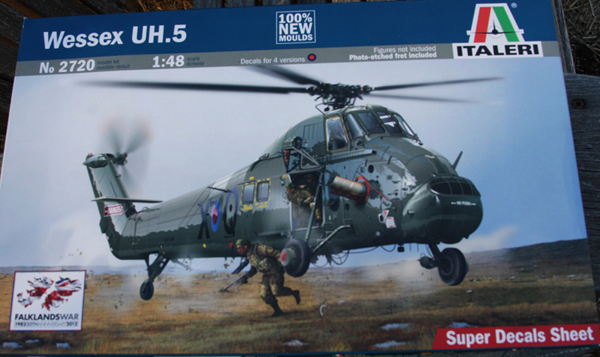
Italeri 1/48 Wessex UH.5
By Stephen Tontoni
Overview
After building the Wessex from the 1/72 Italeri kit last year, I've kind of been bitten by the chopper bug. I did an inbox review and have begun the build review of the 1/72 Cyber-Hobby Sea King, and the quality of this generation of helicopter kits is very impressive. When offered this Italeri Wessex, I figured it would be that level of quality but more detail commensurate with a 1/48 kit. What I've seen has been interesting.
First Impressions
The amount of plastic in the box is very impressive, coming in several sealed bags and all. The big sturdy box it comes in is just plain stuffed. The decal sheet appears to be comprehensive, the modest photo etch fret and mesh are a nice additions, and the instructions look logically organized and clear.
The Kit
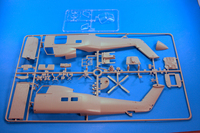 When I opened the bags and surveyed the plastic using 3.5 reading glasses, I was less impressed. First, the plastic has a noticeable pebble finish reminiscent of old Bilek and DML kits. I really haven't seen that roughness on a modern/mainstream kit for a long time. Most, if not all, of the large parts have some flash as well. It's not flash caused by tired worn-out molds; it's a new kit. This flash is like a ridge on the edge of all the larger parts... that's not good and I was annoyed. I separated and cleaned up some of those parts, and knocked off the ridges with a sanding stick (love those things; they see me coming at the beauty supply store). One saving grace is that most of those ridges are on seam lines that will require some sanding anyway. Based on the dry-fit of some of the parts, there will be some filling to do.
When I opened the bags and surveyed the plastic using 3.5 reading glasses, I was less impressed. First, the plastic has a noticeable pebble finish reminiscent of old Bilek and DML kits. I really haven't seen that roughness on a modern/mainstream kit for a long time. Most, if not all, of the large parts have some flash as well. It's not flash caused by tired worn-out molds; it's a new kit. This flash is like a ridge on the edge of all the larger parts... that's not good and I was annoyed. I separated and cleaned up some of those parts, and knocked off the ridges with a sanding stick (love those things; they see me coming at the beauty supply store). One saving grace is that most of those ridges are on seam lines that will require some sanding anyway. Based on the dry-fit of some of the parts, there will be some filling to do.
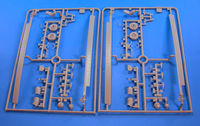 Construction design is pretty simplified; parts that I know should be fairly intricate were simplified in this release. I really like the construction of the interior. Cockpit detailing is pretty good while the use of photo etch in there will really dress it up a lot. The cargo/personnel area and cockpit is built up as one assembly that will drop into the fuselage -- a piece of cake. The ceiling of the cargo area has some cool detailing while the top of that part is the pylon that accepts the rotor post. There's also a part that represents some of the engine detailing. The seats are nicely molded with acceptable (if not a little overdone) wrinkles in the fabric. Take a look at the ejector pin depressions in the fuselage; there's a good chance that a couple will be visible. The fuselage comes in two halves with an underside that's inserted last. There is some sort of piping on that insert that's molded in on this kit, but on their 1/72 kit, it's separate. Usually it would be the other way around, considering the scales; I liked it separate.
Construction design is pretty simplified; parts that I know should be fairly intricate were simplified in this release. I really like the construction of the interior. Cockpit detailing is pretty good while the use of photo etch in there will really dress it up a lot. The cargo/personnel area and cockpit is built up as one assembly that will drop into the fuselage -- a piece of cake. The ceiling of the cargo area has some cool detailing while the top of that part is the pylon that accepts the rotor post. There's also a part that represents some of the engine detailing. The seats are nicely molded with acceptable (if not a little overdone) wrinkles in the fabric. Take a look at the ejector pin depressions in the fuselage; there's a good chance that a couple will be visible. The fuselage comes in two halves with an underside that's inserted last. There is some sort of piping on that insert that's molded in on this kit, but on their 1/72 kit, it's separate. Usually it would be the other way around, considering the scales; I liked it separate.
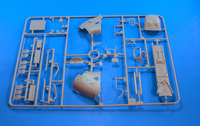 The nose will probably be a problem area; it's obvious that they'll provide a different nose to do a Choctaw. That's smart and I'm sure that people will be excited when they release that. The nose assembly in the Wessex kit looks over-engineered to me. It consists of five parts that don't seem to fit very well together. They are: two halves, chin, air intake frame and air intake grill. For that grill, you can use the styrene part or photo-etch/mesh; that's a nice touch. Still, I can tell already that it's going to be a clumsy build and will take some filler to make it look good. I advise great caution here and many dry-fittings.
The nose will probably be a problem area; it's obvious that they'll provide a different nose to do a Choctaw. That's smart and I'm sure that people will be excited when they release that. The nose assembly in the Wessex kit looks over-engineered to me. It consists of five parts that don't seem to fit very well together. They are: two halves, chin, air intake frame and air intake grill. For that grill, you can use the styrene part or photo-etch/mesh; that's a nice touch. Still, I can tell already that it's going to be a clumsy build and will take some filler to make it look good. I advise great caution here and many dry-fittings.
Other Stuff
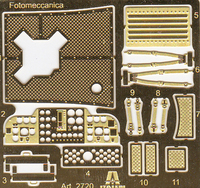 There is a brass photo-etch fret with the kit, about 2" x 2" at most. It's used very appropriately; grills, seat harnesses and other two dimensional bits. I think that is an excellent addition to the kit.
There is a brass photo-etch fret with the kit, about 2" x 2" at most. It's used very appropriately; grills, seat harnesses and other two dimensional bits. I think that is an excellent addition to the kit.
The decal sheet has four marking options and an impressive set of stencils and other standard markings. Decals are very thin and in good register. A couple of them are very colorful, and others are for the 30th Anniversary of the Falklands War. They're all excellent choices. When they get to the Choctaw, the marking options will go through the roof.
Conclusions
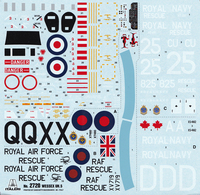 This kit will build into a BIG impressive model on the display table or shelf. It will take a bit of work, but you can definitely get there from here. I am just unimpressed with the styrene. Molding is soft and the detail is fairly sparse by 2012 standards. Flush rivets seem to vary greatly in depth and diameter. Flat surfaces have a definitely rough finish like Bilek and DML. In fact, the level of molding, rough finish, and over-engineering reminds me strongly of early 1990's DML kits such as their MiG-15, MiG-17, their He-219, and so forth. Those kits also looked great in the box, and had a cute little photo etch frets, but were heart-breaking ill-fitting putty-monsters.
This kit will build into a BIG impressive model on the display table or shelf. It will take a bit of work, but you can definitely get there from here. I am just unimpressed with the styrene. Molding is soft and the detail is fairly sparse by 2012 standards. Flush rivets seem to vary greatly in depth and diameter. Flat surfaces have a definitely rough finish like Bilek and DML. In fact, the level of molding, rough finish, and over-engineering reminds me strongly of early 1990's DML kits such as their MiG-15, MiG-17, their He-219, and so forth. Those kits also looked great in the box, and had a cute little photo etch frets, but were heart-breaking ill-fitting putty-monsters.
There is definitely more detail in this 1/48 Wessex as compared to their 1/72 Wessex from many years ago, but the molding in their 1/72 kit is better and cleaner. As is evidenced by the molding and design of the recent 1/72 Cyber-Hobby Sea King, as technology has surged ahead, modelers' expectations have equally risen. This kit has the sort of detailing that we loved in the early 1990s but the bar is FAR higher than it was back then.
If you really like the Wessex/Choctaw in 1/48, this is the kit for you. If you're more or less lukewarm to it as I am, I'd wave off on this one. My thanks to MRC for the review copy.
